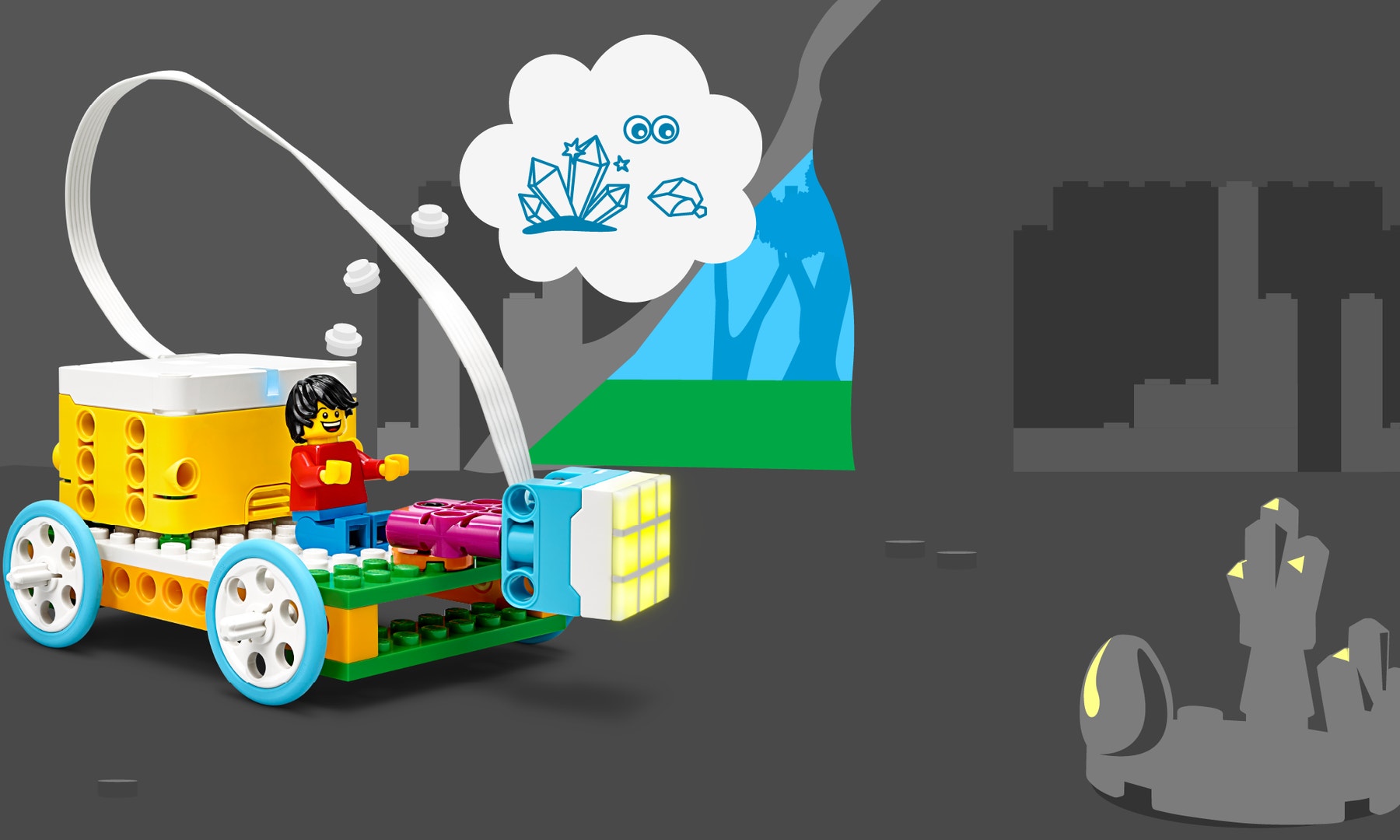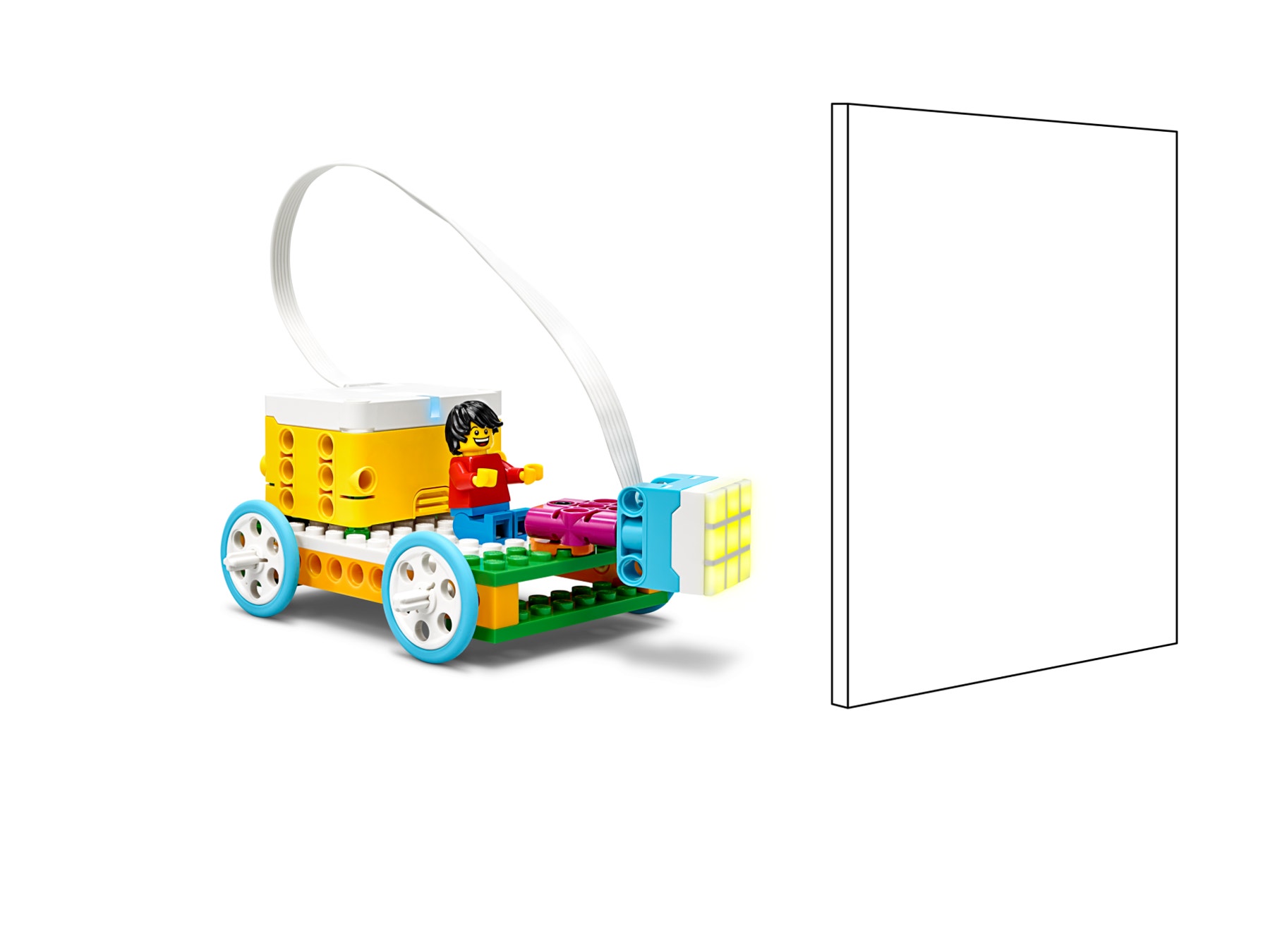How Eyes See
Daniel finds something while exploring a dark cave. Can you help him see it better?

Prepare
(NOTE: This lesson contains a Part A and a Part B. Both are important to access the full learning of the curriculum. If time is limited, review both parts to choose elements that meet your students’ needs.)
In this lesson, the key learning is in exploring the way light affects our ability to see. Students will build a movable light, using the example image(s), building instructions and programming ideas for inspiration. Encourage them to design and build their own ideas for a movable light if they prefer.
- Build Prior Knowledge - How Eyes See: Using your core science materials, share information, images and definitions.
- When light reflects (bounces) off objects, it enters the eye.
- The retina is the part of the eye that detects light and colour.
- The eye sends signals about this light – and colour – to the brain, which uses this information so that we see objects.
- Key vocabulary: reflected light, eye, retina
- Building and Programming Experience: Review the suggestions in the Unit Plan. For this lesson, you may also want to
- Reinforce with the Motor and Light tutorials in the SPIKE App Start menu.
- Use the Event and Light Blocks sections of the Help> Word Blocks menu in the SPIKE App to provide more support.
- Add the motor in your model so that the car can move to a new location and PROGRAM it (Hint: See an inspiration model in the Big Bus lesson) to provide inspiration and building support for Elaborate.
- Materials: Students will need a relatively dark space to see the matrix light. Consider closing curtains, lowering overhead lights or providing big cardboard boxes with a peek hole for model testing.
PART A (45 minutes)
Engage
(Whole Class, 10 minutes)

Introduce the story’s main character(s) and the first challenge: Daniel finds something while exploring a dark cave. Can you help him see it better?
THINK – Facilitate a brief discussion about the lesson topic(s) using the story picture if you wish.
- How can we see objects in a dark environment? (Use a torch or other light to reflect the object.)
- If the path of light is blocked to an object, how does that affect our ability to see it? (Since light cannot pass through to the object, it cannot reflect any light. Without light, our eyes cannot send signals about the object to the brain and so we cannot see it clearly.)
- What can we do to see an object if light is blocked from it? (Move the light, move what’s blocking the light or move the object.)
Distribute a SPIKE Essential Set and a device to each group.
Explore
(Small Groups, 25 minutes)
As students work, reinforce that the image(s) and building instructions show one idea for a car and light. Students may design and build their own movable light idea.
Have students:
- Use the base model to BUILD a model car to help Daniel see objects in the cave. Add a light to the front of his car.
- PROGRAM their model to show how a path of light lets an object be seen.
- Test the model (using the darkened space you provide – see Prepare).
Facilitate brainstorming about ways to use LEGO® elements to model the role of light in vision. For example, the students can use the light matrix like a torch and a LEGO plate as a “wall” to block the light to an object. Moving these elements – the light and the wall – will help students explore how changes in the path of the light affect the ability to see the object.
Halfway through work time, have students exchange ideas using a familiar classroom routine and then update their models with inspiration from sharing.
Example Ideas


Explain
(Whole Class, 10 minutes)
Gather students for sharing.
Have each group use their model to demonstrate and explain:
- How light reflected from an object enters the eye so that we can see it.
- Why we can’t see an object when the path of light to the object is blocked.
Invite students to share how they changed their model to improve its performance.
If you wish to continue to Part B – Explain, have students keep their models intact or allow time for rebuilding.
PART B (45 minutes)
Explain
(Whole Class, 10 minutes)
- Repeat the steps from Part A – Explain to have additional groups demonstrate and explain their learning.
Elaborate
(Whole Class, 30 minutes)
(5 min) Share background to help students Elaborate: Discuss why moving the car would change the path of the light when the wall is still there. (The path of light was blocked by the LEGO plate “wall.” Moving the car to the left or right allows the light to avoid the wall.)
(15 min) Have your students iterate and test their models to complete the next challenge in the app:
- PROGRAM the motor in your model so that the car can move to a new location. (Hint: See an inspiration model in the Big Bus lesson.)
- Show how the car’s location changes the path of light and affects Daniel’s ability to see it. Explain if moving the car could help Daniel see the object better and if so, how.
(10 min) Invite students to share knowledge, ideas or skills that
- Helped them complete the challenge.
- They learned while building.
Have students clean up the sets and work areas.
Evaluate
(Whole Class, 5 minutes)
- Ask guiding questions to elicit students’ thinking and their decisions while ideating, building and programming.
Observation Checklist
Review the learning objectives (Teacher Support box).
Use the checklist to observe students’ progress:
- Their model includes a light that can be moved to new locations.
- They use the model to describe that our eyes need light reflected from an object for it to be seen.
- They use the model to explain that blocking the path of light to an object means we cannot see the object.
Self-Assessment
Have each student choose the brick that they feel best represents their performance。
- Blue brick: I think I can follow instructions to create a program.
- Yellow brick: I can follow instructions to create a program.
- Green brick: I can follow instructions to create a program and I can help a friend do it too.
Peer Feedback
In their small groups, have your students discuss their experiences working together.
Encourage them to use statements like these:
- I liked it when you…
- I’d like to hear more about how you…
Differentiation
Simplify this lesson by:
- Adjusting the first challenge: Have students build and program a light (using the light matrix) without the car. Ask them to test their light on objects with and without the wall as an obstruction.
Increase the difficulty by:
- Extending the Elaborate challenge: Have students change their Elaborate models by programming the pixel brightness of their light matrix from 0%, 25%, 50%, 75%, to 100%. Ask them to observe how their ability to see an object changes with the different levels of brightness.
Extension
- Provide learning materials about animals (unlike humans) that can see very well in the dark. Ask students to choose one of these animals and write a brief newspaper article that describes how and how far it sees in the dark.
If facilitated, this will extend beyond the 45-minute lesson.
Teacher Support
Students will:
- Build an accurate model of a movable light source.
- Use the model to describe how light reflects from objects to enter the eyes, allowing the objects to be seen.
- Use the model to explain what happens if the light source is blocked or diminished.
(one for every two students)
- LEGO® Education SPIKE™ Essential Set
- Device with the LEGO Education SPIKE App installed
- See Prepare - Materials
ACSSU080 ACTDEP015 ACTDIK008 ACELY1690 ACELY1694
Science (Physical Sciences)
Year 5 Light and Sound:
ACSSU080: "Light from a source forms shadows and can be absorbed, reflected, and refracted."
Technologies (Design and Technologies)
Years 3 to 6 Investigating and Designing:
ACTDEP015: "Critique needs or opportunities for designing exploring and testing a variety of materials, components, tools, and equipment and the techniques needed to produce designed solutions."
Technologies (Digital Technologies)
Years 3 and 4 Implementing Digital Solutions:
ACTDIK008: “Implement digital solutions as simple visual programs involving branching, iteration (repetition), and user inputRecognise different types of data and explore how the same data can be represented in different ways.”
English (Literacy)
Year 4 Language for social interactions:
ACELA1490: "Understand that social interactions influence the way people engage with ideas and respond to others for example when exploring and clarifying the ideas of others, summarising their own views and reporting them to a larger group."
English (Literacy - Language Arts Extension)
Year 4 Creating Texts:
ACELY1694: "Plan, draft and publish imaginative, informative and persuasive texts demonstrating increasing control over text structures and language features."




